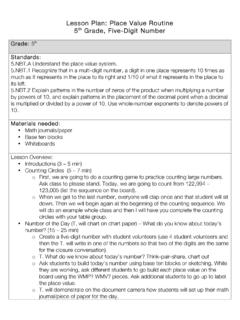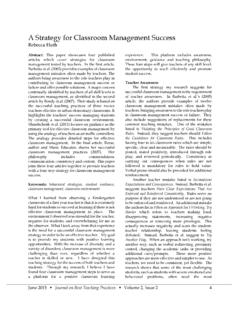Transcription of Instrument inspection - IAHCSMM
1 Instrument inspection CIS Self-Study lesson plan lesson No. CIS 245 ( Instrument Continuing Education - ICE) by Donna Swenson, BS, CRCST, CHL, ACE, CSPDM. President, Sterile Processing Quality Services Inc. Sponsored by: S. Learning Objectives urgical instruments must be inspected for cleanliness 1. Stress the importance of inspecting and proper functioning before they are placed in sets for use in surgical and surgical instrumentation in compliance other procedures. Those that are not functioning properly or that are not clean with the manufacturer's instructions can cause serious issues for patients and surgical staff. Instrument inspection is before assembling instruments into sets a multi-step process that begins with determining if an Instrument is clean, structurally 2.
2 Explain when and how to test instru- intact and properly functioning. This lesson reviews common inspection steps for all ments for organic/detergent residuals instruments and specific procedures for frequently used instruments . 3. Describe basic inspection procedures required for all surgical instruments to check for cleanliness, stains, corrosion, Objective 1: Stress the placements must be located and trans- cracks, and breakage, and stiffness of importance of inspecting ferred to the surgical suite. Any of the movable parts surgical instrumentation situations just described might result in 4. Discuss techniques to inspect common in compliance with the the patient needing additional treatment instruments : manufacturer's instructions including antibiotic therapy or further Scissors before assembling surgery that could have been avoided Insert tips on various instruments instruments into sets if proper Instrument inspection had Ratchets Surgical instruments that are not prop- preceded placement in the Instrument set Rongeurs erly cleaned can create serious problems and sterilization.
3 Bone cutters if they are used. For example, debris Careful attention to the manufacturer's Bone curette remaining on a surgical Instrument can Instructions for Use (IFU) for surgical Chisels and osteotomes cause an adverse reaction if a patient is instrumentation is required because they exposed to it. Granulomas can develop explain necessary cleaning and inspecting from small particles of debris that enter procedures. If the IFU are not consistently Instrument Continuing Education (ICE) lessons the surgical site when the patient's im- and carefully followed, bioburden may be provide members with ongoing education in mune system attacks the debris particles left on or in the instruments . the complex and ever-changing area of surgical Instrument care and handling.
4 These lessons are that fall from the Instrument . Depending on each Instrument 's designed for CIS technicians, but can be of value Another cause of granulomas arises features, magnification might be required to any CRCST technician who works with surgical when a stress fracture on an Instrument for inspection . A lighted magnifying glass instrumentation. causes it to break during use, and a or telescope can be used to determine if Earn Continuing Education Credits: portion of the Instrument drops in the small discolorations are actually debris Online: You can use these lessons as an in-service surgical site. In both instances, since the that was not removed by the cleaning with your staff, or visit for online grading at a nominal fee. body's immune system cannot eliminate process.
5 Meticulous attention to the IFU. the debris, it walls off the substance in will help to minimize any possibility By mail: For written grading of individual lessons, an attempt to prevent the debris from that debris or bioburden remains on the send completed 15-question quiz and $15. to: PEC Business Office, Purdue University, Stew- causing harm. Granulomas can grow over Instrument after cleaning. art Center Room 110, 128 Memorial Mall, West time, cause pain and discomfort and, Lafayette, IN 47907-2034. sometimes, require surgical removal. Objective 2: Explain when and Scoring: Each 15 question online quiz with a Improperly cleaned instruments may how to test instruments for passing score of 70% or higher is worth two points not be effectively sterilized. If debris is organic/detergent residuals (2 contact hours) toward your CIS re-certification baked onto an Instrument 's surface, it can The validated cleaning process developed (6 points) or CRCST re-certification (12 points).
6 IAHCSMM provides online grading service for provide protection during sterilization by the washing equipment and instru- any of the lesson plan varieties. Purdue University to any bacteria under the debris. If the ment manufacturers should be verified provides grading services solely for CRCST and debris is dislodged during surgery, the periodically to ensure the process is CIS lessons. patient may develop an infection when effective. Non-routine testing may also More information: Direct any questions about the bacteria enter the surgical site. be useful to evaluate the effectiveness online grading to IAHCSMM at instruments that malfunction create of training programs. Poor results will Questions about written grading are answered by Purdue University at challenges for the surgical team as re- indicate that applicable employees need SEPTEMBER / OCTOBER 2014 Communiqu.
7 CIS Self-Study lesson plan retraining and/or additional practice to to be found on the instruments . Any correctly undertake the cleaning process. positive result must be investigated. Special Instrument testing may also be The test solution must be removed from important after equipment is repaired the instruments ' surfaces after testing and before it is returned to service. is complete as part of the re-cleaning Basic tactics for special Instrument process, and the applicator used for the testing include selecting a representative test solutions should be disposed of in a number of instruments that will biohazard container. be checked for soil residuals. Those Two basic types of tests can be used to chosen should be difficult to clean, and determine if Instrument surfaces are free results should be recorded for quality of detergent residuals and inorganic and assurance purposes.
8 Organic soils. Each department or facility must The first basic type uses a swab or test determine the frequency and type of strip that is exposed to the surface of the testing and the number of instruments device being tested. Note: different swabs to be tested. Decisions should be based or test strips are specific for different on the volume and type of instrumenta- types of soil such as protein, blood or tion processed and types of soil expected carbohydrates. A swab is moistened with sterile or tap water and is wiped on the surface of the device being tested. If the All surgical instruments q CLEANLINESS test substance is not on the surface of the Instrument being tested, the swab must be inspected for will remain its original color. If the test substance is present on the Instrument 's q STAINS.
9 Cleanliness, stains, surface, the swab will turn a different col- or to indicate the Instrument is not clean corrosion, cracks, q CORROSION and must be re-cleaned before being placed in a set. breakage, and stiffness A variation of the swab or test strip method involves use of a vial of test of movable parts q CRACKS solution. Swab surfaces on all areas of the Instrument with a dry cotton appli- before being placed q BREAKAGE cator dampened with tap or sterile water, in Instrument sets. If and place the tip of the swab in the test solution. If the solution turns color it possible, instruments q STIFFNESS OF indicates that a residual of the type of soil being tested is present, and the cleaning should be checked under MOVING PARTS process should be studied and corrected, as necessary.
10 Magnification because There are test devices available for test- ing general instruments , lumens, flexible small pieces of bioburden endoscopes, and robotic devices. Gloves should be worn when testing for proteins. or debris can otherwise be The second basic type of test used to check instruments for detergent residuals difficult to see. and inorganic and organic soils involves analysis for adenosine triphosphate (ATP). ATP is a substance present in Communiqu SEPTEMBER / OCTOBER 2014 CIS Self-Study lesson plan all life and, therefore, will be present Each of these features can harbor small surface of the stain. If the stain comes in any organic debris present on the amounts of debris or bioburden. off and the underneath surface is undam- instruments . Living and growing cells A variety of stains can be found on an aged, it is a stain.







